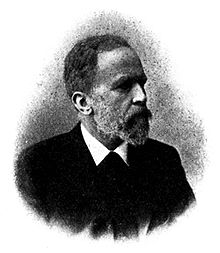Bernhard Naunyn

Bernhard Naunyn(2 September 1839 – 26 July 1925) was a Germanpathologist,born inBerlin.
Biography[edit]
After receiving his degree at theUniversity of Berlinin 1863, he became an assistant to pathologistFriedrich Theodor von Frerichs(1819–1885) at theCharité.Afterwards he was the head of medical clinics inDorpat(1869–1871),Bern(1871–1872),Königsberg(1872–1888), andStrasbourg,where he also taught at theImperial University(1888–1904).
Naunyn is remembered for his work inexperimental pathology,particularly metabolic pathology; also referred to asxenobioticmetabolism.It was during the time he spent working at Frerich's clinic in Berlin that he became interested in the metabolic pathology regarding theliver,pancreasand other internal organs. In his studies of the fermentation processes of thestomach,he noticed the "contra-fermentation" properties ofbenzene.He discovered that the human organism excretedphenolafter it had received benzene. With physicianOtto Schultzen(1837–1875) he discovered that benzene-derivedhydrocarbonsin the body had the ability to perform chemistry that was not possible for chemists to achieve in a conventional laboratory.
WithpharmacologistOswald Schmiedeberg(1838–1921) and pathologistEdwin Klebs(1834–1913) he foundedArchiv für experimentelle Pathologie und Pharmakologie(now published asNaunyn-Schmiedeberg's Archives of Pharmacology), and in 1896 withsurgeonJan Mikulicz-Radecki(1850–1905) he foundedMitteilungen aus dem Grenzgebieten der Medizin und Chirurgie.A famous student of Naunyn's wasOtto Loewi(1873–1961), who was the winner of theNobel Prize in Physiology or Medicinein 1936.
His grave is preserved in theProtestantFriedhof II der Jerusalems- und Neuen Kirchengemeinde(Cemetery No. II of the congregations ofJerusalem's ChurchandNew Church) inBerlin-Kreuzberg,south ofHallesches Tor.
Cholelithiasis and diabetes research[edit]
Naunyn made contributions in his research ofcholelithiasisanddiabetes.He published an important treatise on diabetes titledDer Diabetes mellitus(1898), and hisKlinik der Cholelithiasiswas translated into English byArchibald Garrod(1857–1936) as "A treatise on cholelithiasis" (1896).[1]WithOskar Minkowski(1858–1931), he theorized thatbile pigmentformation was a function of liver cells alone, however this theory was later disproved by John William McNee in 1913.[2]
Naunyn proposed a strictlow-carbohydrate dietfor diabetic patients.[3]He was one of the few German researchers influenced by theCantani systemwho locked patients in their rooms for months at a time when necessary for them to abstain from sugar.[4]Frederick Madison Allendescribed Naunyn as a "champion of strict carbohydrate-free diet in a German medical congress where most of the speakers opposed it".[4][5]
In 1889, it was noted that "Naynyn, who, in accordance with the principles of Cantani, demands the strictest meat-diet."[6]However, Naunyn later relaxed his dietary treatment based on the tolerance of caloric and carbohydrate requirements for each patient.[7]In 1906, Naunyn was the first to use the term "acidosis",by which he meant the accumulation ofketonebodies.[8][9]
References[edit]
- ^WorldCat SearchA treatise on cholelithiasis
- ^[1]Oskar Minkowski @Who Named It
- ^Zinmanet al.(2017).Diabetes Research and Care Through the Ages.Diabetes Care40 (10): 1302-1313.
- ^abAllen, Frederick M; Stillman, Edgar; Fitz, Reginald (1919)."Total Dietary Regulation in the Treatment of Diabetes"(PDF).Monograph of the Rockefeller Institute for Medical Research.11:37.
{{cite journal}}:CS1 maint: multiple names: authors list (link) - ^Gentilcore, David; Smith, Matthew. (2018).Proteins, Pathologies and Politics Dietary Innovation and Disease from the Nineteenth Century.Bloomsbury Publishing. p. 27.ISBN978-1350056862
- ^Schnee, Emil. (1889).Diabetes: Its Cause and Permanent Cure.London:H. K. Lewis.p. 138
- ^Duncan, Garfield George. (1951).Diabetes Mellitus: Principles and Treatment.Saunders. p. 9
- ^"I Introduction: 1. Definition of the Term Acidosis".Acta Medica Scandinavica.126:12–27. 1946.doi:10.1111/j.0954-6820.1946.tb02148.x.
- ^L'Esperance, Francis A; James, William A. (1981).Diabetic Retinopathy: Clinical Evaluation and Management.Mosby. p. 118.ISBN9780801629488
